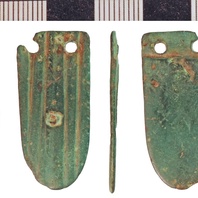
Viking Objects
Copper-Alloy Strap-End (NLM-B633CE)
The decoration on this cast copper-alloy strap-end involves a series of deep longitudinal grooves which may actually represent previous damage. If decorative, the object is similar to Thomas Class E Type 3 strap ends whose distribution generally falls in the eastern Danelaw and around the Irish Sea. Strap ends came in various styles and were fairly common throughout the Viking world. They were used to decorate the ends of belts and to stop them getting damaged.
Read More
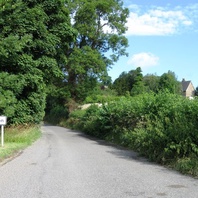
Viking Names
Kirk Ireton
The first element of Kirk Ireton, in the Wirksworth Hundred of Derbyshire, is the genitive singular or plural of the Old Norse ethnonym Íri, ‘an Irishman; probably also a Norseman who had lived in Ireland’ combined with the Old English element tun ‘an enclosure; a farmstead; a village; an estate’. Old Norse kirkja ‘a church’ was affixed at a later date. Traditionally, the place-name has been interpreted as referring to a settlement of Irishmen; probably Norsemen who lived in Ireland. However, the exact implications of such a name are not yet fully understood and are the subject of ongoing work by Dr Jayne Carroll of the Institute for Name-Studies, University of Nottingham.
Read More
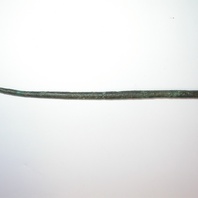
Viking Objects
Ring-headed Pin (1981/166-2568)
This copper alloy ring-headed pin was used for fastening cloaks and discovered during excavations at Full Street, Derby. Pins like this were common in Ireland and the western British Isles, and spread further afield under Viking influence.
Read More
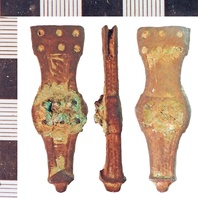
Viking Objects
Irish Strap-End (NLM-A30415)
This Irish-type strap-end has been classified as a Thomas Class F strap-end. One of the panels seems to have retained a possible reticulated interlace pattern while the inner area is decorated with six dots of inlay. Its manufacture is possibly traced to Dublin between c. 950-1050 and it is likely linked to Viking distribution of Irish artefacts. Strap-ends came in various styles and were fairly common throughout the Viking world. They were used to decorate the ends of belts and to stop them getting damaged.
Read More
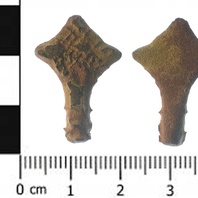
Viking Objects
Kite-Shaped Pin (SWYOR-53AEC4)
This type of kite-shape-headed pin is considered to be of Irish origin and imported through Viking activities.
Read More
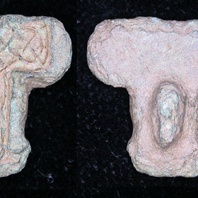
Viking Objects
Irish Gilded Mount (LEIC-09D1C8)
This fragment of a gilded copper-alloy mount is roughly T-shaped, and has a raised border around a panel of chip-carved interlace which has traces of gilding. It is possible that it made its way to England prior to Viking incursions but it is equally likely that the Vikings brought this brooch with them as plunder after raiding various areas in Ireland.
Read More
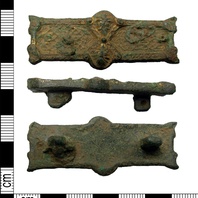
Viking Objects
Gilded Mount (LEIC-127138)
This mount is decorated with rope-like raised decoration, flanked by a plain raised edge. The centre of the mount is decorated with a raised ‘saltaire’ cross. Above and below this cross are semi-circular projections which form the upper part of human face masks which face each other. The remainder of the upper surface is filled with loose ‘chip carved’ interlace. The whole upper surface has patches of gilding, suggesting it originally covered the whole surface. It is possible that it made its way to England prior to Viking incursions but it is equally likely that the Vikings brought this brooch with them as plunder after raiding various areas in Ireland.
Read More
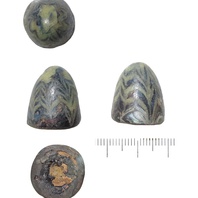
Viking Objects
Glass Gaming Piece (LIN-C31CD7)
There are different possible interpretations of this Lincolnshire find from 2012. It could be a playing-piece as interpreted in the reproductions. Anglo-Saxon playing-pieces of shaped animal tooth are of similar dimensions, while glass counters were used both in the Roman period and taller glass playing men in the Viking period. This find is however considered by some archaeologists more likely to be a decorative setting from fine metalwork. The rather muddy glass colours suggest that the glasses used had already been recycled, and the clay core indicates careful use of a precious resource as well as a means of moulding on a decorated sheet of glass. The best parallels for this find, though none matches the form, are the oval cabochon pieces of dark blue and opaque white glass from the Anglo-Saxon monastery at Monkwearmouth, County Durham. Prominent coloured glass inlays are a part of the Insular tradition with its roots in Ireland. In Irish work the emphasis is on contrasting coloured zones and inlays, technically more complex and in a diverging tradition from this new find, though imitated elsewhere in English work.
Read More
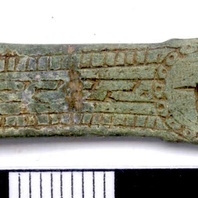
Viking Objects
Irish Strap-End (NARC-3835F4)
This Irish type strap-end is classed as Thomas Class F. The decoration consists of a zoomorphic terminal and panels of interlace. Its manufacture is possibly traced to Viking Age Dublin and is likely linked to Viking distribution of Irish artefacts. Strap-ends came in various styles and were fairly common throughout the Viking world. They were used to decorate the ends of belts and to stop them getting damaged.
Read More
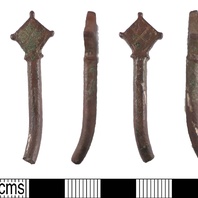
Viking Objects
Kite-Shaped Pin (PUBLIC-D9CE19)
This incomplete copper-alloy and niello pin is composed of a flat kite-shaped head with small rounded knop protrusion to three points. Both faces of the head are decorated with a cross that radiates to a narrow border and is inlaid with niello. These types of pins are generally considered to be of Irish origin and imported through Viking activities.
Read More
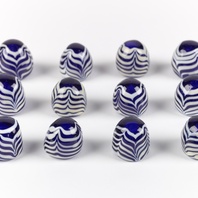
Viking Objects
Reproduction Glass Gaming Pieces
These are reproductions of a conical glass stud found in Lincolnshire, interpreted here as gaming pieces. However analysis of the original on which they are modelled suggests that it could also have been a glass fitting on decorative metalwork.
